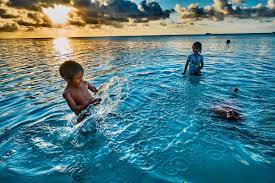More than 90% of drowning deaths occur in low- and middle-income countries, with children under the age of 5 being at highest risk. These deaths are frequently linked to daily, routine activities, such as bathing, collecting water for domestic use, travelling over water on boats or ferries, and fishing. The impacts of seasonal or extreme weather events – including monsoons – are also a frequent cause of drowning and these impacts are largely preventable through a number of interventions.
“Every year, around the world, hundreds of thousands of people drown. Most of these deaths are preventable through evidence-based, low-cost solutions,” said WHO Director-General Dr Tedros Adhanom Ghebreyesus. “Today, cities around the world are lighting up their monuments in blue light as a call to action for each of us to do our part to prevent drowning. Let’s put a stop to drowning.”
“Drowning is a global public health challenge, and at Bloomberg Philanthropies, we’re focused on implementing solutions to prevent it. Today, we’re joining our partners around the world in recognizing World Drowning Prevention Day and taking action,” said Michael R. Bloomberg, founder of Bloomberg Philanthropies and WHO Global Ambassador for Noncommunicable Diseases and Injuries. “In many cases, we know what works to prevent drowning. We’ve developed tools and guidance to help governments implement solutions – and if we do more together, we really can save thousands of lives.”
WHO recommends 6 evidence-based measures to prevent drowning, including installing barriers controlling access to water; training bystanders in safe rescue and resuscitation; teaching school-aged children basic swimming and water safety skills; providing supervised day care for children; setting and enforcing safe boating, shipping and ferry regulations; and improving flood risk management.
This year, the theme of World Drowning Prevention Day invites the global community to “do one thing” to prevent drowning. Examples of actions that can be taken are as follows:
- Individuals can share drowning prevention and water safety advice with their families, friends and colleagues, sign up for swimming or water safety lessons, or support local drowning prevention charities and groups.
- Groups can host public events to share water safety information, launch water safety campaigns, or commit to developing or delivering new drowning prevention programmes using recommended best practice interventions.
- Governments can develop or announce new drowning prevention policies, strategies, legislation or investment, convene multisectoral roundtables or parliamentary discussions on drowning burden and solutions, and introduce or commit to supporting drowning prevention programming domestically or internationally.
Many countries in the world have committed to drowning prevention programmes. Bangladesh has started a 3-year program to reduce drowning among children throughout the country. As part of the program, the government will take over the 2 500 daycares established and funded by Bloomberg Philanthropies since 2012, and will expand the program by adding an additional 5 500 daycares to provide supervision to 200 000 children ages 1–5 years.
Notes to Editors:
WHO works with partners including Bloomberg Philanthropies, the Royal National Lifeboat Institution (RNLI) and the Global Health Advocacy Incubator as well as other UN agencies to raise awareness on drowning prevention.
Together, we are supporting Member States to design and implement drowning prevention initiatives based on published guidance documents. With Bloomberg Philanthropies’ support, Bangladesh and Vietnam have identified and scaled up cost-effective approaches to drowning prevention among children, Uganda and Ghana are receiving support to study the circumstances of drowning.
WHO has published a growing library of drowning prevention assessments and guidance documents. The 2014 Global Report on Downing: Preventing a leading killer. In May 2022, WHO published its latest guidance on best practice recommendations for three of these interventions: the provision of day-care for children, basic swimming and water safety skills, and safe rescue and resuscitation training.
The Bloomberg Philanthropies Initiative to Prevent Drowning supports drowning-prevention activities in Bangladesh, Uganda and Viet Nam, including supervision of young children in daycare, survival swimming instruction to children ages 6–15, and enhanced data collection.
In 2021, the first UN General Assembly resolution was adopted on drowning prevention. The resolution asks WHO to coordinate drowning prevention actions within the UN System and lead preparations for World Drowning Prevention Day.











